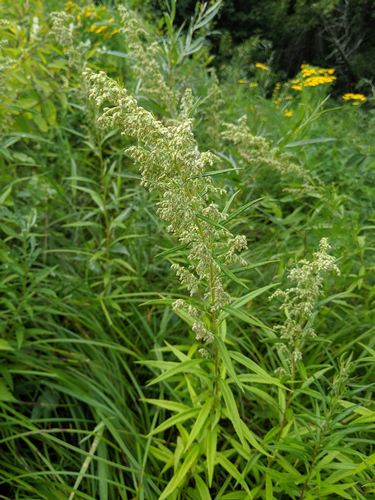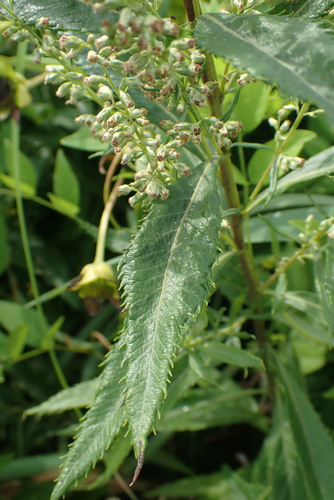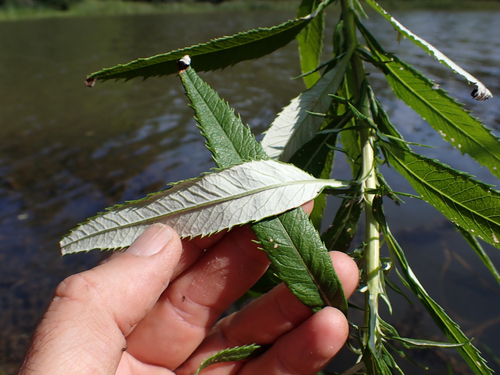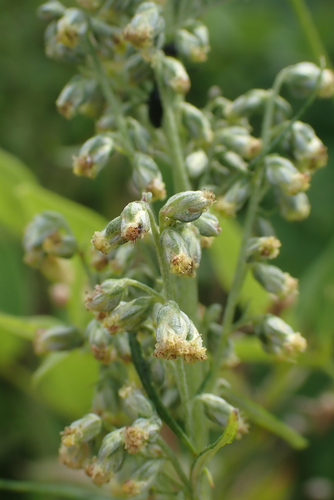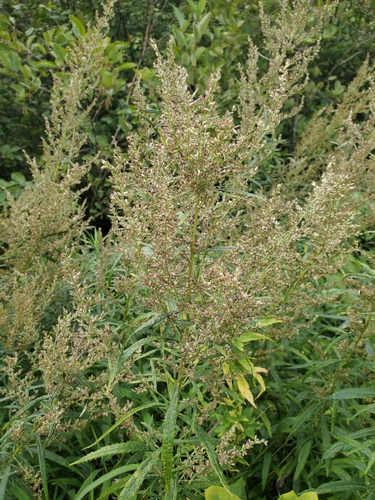Plants and Animals
Artemisia serrata Sawtooth wormwood
Key Characteristics
Sawtooth wormwood is a tall (up to 300 cm (118 in), herbaceous perennial with simple, regulary serrate, lanceolate leaves that are glabrous above and white tomentose below. Flowers are either bisexual or female, discoid, green-yellow florets gathered in many flowerheads on a raceme-like panicle that reach a length of 10 – 15 cm (4 – 6 in). The fruit is a small achene (i.e., cypsela), ellipsoid, nerveless, and about 1 mm (0.04 in) long.
Sawtooth wormwood can be distinguished from most species of Artemisia in Michigan by its simple, unlobed leaves. It is most likely to be confused with western mugwort, but sawtooth wormwood stems are sparsely tomentose to glabrous and its upper leaf surfaces are always glabrous.
Status and Rank
US Status: No Status/Not Listed
State Status: T - Threatened (legally protected)
Global Rank: G4?Q
State Rank: SNR - Not ranked
Occurrences
| County | Number of Occurrences | Year Last Observed |
|---|
Information is summarized from MNFI's database of rare species and community occurrences. Data may not reflect true distribution since much of the state has not been thoroughly surveyed.
Habitat
Across its range, sawtooth wormwood grows in a variety of habitats, but it usually occurs on bluffs or ridges adjacent to rivers, river floodplains and streams, along the edges of woods and marshes, on railroad embankments and prairies adjacent to railroad rights-of-way, and along ruderal roadsides (COMH 2025). Plants typically grow in sandy soils but can grow in rich, silty, or loamy soils as well.
Natural Community Types
For each species, lists of natural communities were derived from review of the nearly 6,500 element occurrences in the MNFI database, in addition to herbarium label data for some taxa. In most cases, at least one specimen record exists for each listed natural community. For certain taxa, especially poorly collected or extirpated species of prairie and savanna habitats, natural community lists were derived from inferences from collection sites and habitat preferences in immediately adjacent states (particularly Indiana and Illinois). Natural communities are not listed for those species documented only from altered or ruderal habitats in Michigan, especially for taxa that occur in a variety of habitats outside of the state.
Natural communities are not listed in order of frequency of occurrence, but are rather derived from the full set of natural communities, organized by Ecological Group. In many cases, the general habitat descriptions should provide greater clarity and direction to the surveyor. In future versions of the Rare Species Explorer, we hope to incorporate natural community fidelity ranks for each taxon.
Associated Plants
Box-elder (Acer negundo), silver maple (Acer saccharinum), big bluestem (Andropogon gerardii), tall green milkweed (Asclepias hirtella), common milkweed (Asclepias syriaca), kitten-tail (Besseya bullii), Joe-Pye-weed (Eutrochium maculatum), sawtooth sunflower (Helianthus grosseserratus), spotted touch-me-not (Impatiens capensis), wild-bergamot (Monarda fistulosa), reed canary grass (Phalaris arundinacea), cut-leaf coneflower (Rudbeckia laciniata), sandbar willow (Salix interior), cup plant (Silphium perfoliatum), Canada goldenrod (Solidago canadensis), late goldenrod (Solidago gigantea), prairie cordgrass (Spartina pectinata), and stinging nettle (Urtica dioica).
Management Recommendations
A status survey for this species is warranted in the western Upper Peninsula of Michigan to recognize its full extent in Michigan. This species requires somewhat dry soil, typically on slopes, near streams, and, depending on surrounding remnant habitat, periodic low intensity fire. National hydrologic regimes should be maintained. Maintain healthy habitat and minimize fragmentation. Control invasive species and limit use of herbicides, and if used, minimize potential non-target effects.
Survey Methods
-
Meander Search
-
Survey Period: From second week of July to fourth week of September
-
References
Survey References
- Elzinga, C.L., D.W. Salzer, and J.W. Willoughby. 1998. Measuring and Monitoring Plant Populations. The Nature Conservancy and Bureau of Land Management, Denver. BLM Technical Reference 1730-1. 477pp.
- Goff, G.F., G.A. Dawson, and J.J. Rochow. 1982. Site examination for Threatened and Endangered plant species. Environmental Management 6(4): 307-316
- Nelson, J.R. 1984. Rare Plant Field Survey Guidelines. In: J.P. Smith and R. York. Inventory of rare and endangered vascular plants of California. 3rd Ed. California Native Plant Society, Berkeley. 174pp.
- Nelson, J.R. 1986. Rare Plant Surveys: Techniques For Impact Assessment. Natural Areas Journal 5(3):18-30.
- Nelson, J.R. 1987. Rare Plant Surveys: Techniques for Impact Assessment. In: Conservation and management of rare and endangered plants. Ed. T.S. Elias. California Native Plant Society, Sacramento. 8pp.
Technical References
- Consortium of Midwest Herbaria (COMH). 2025. Biodiversity occurrence data published by:?Illinois Natural History Survey, University of Minnesota Herbarium, The Morton Arboretum Herbarium – Vascular Plants, Wisconsin State Herbarium – Vascular Plants, and Chadron State College, High Plains Herbarium. Accessed through Midwest Herbaria Portal Data Portal. <https://midwestherbaria.org/portal/index.php>. Accessed 9 September, 2025.
- NatureServe. 2023. NatureServe Network Biodiversity Location Data accessed through NatureServe Explorer Web. <https://explorer.natureserve.org/>. Accessed 3 March, 2025.
- Reznicek, A.A., E.G. Voss, and B.S. Walters. 2011. Michigan Flora Online. University of Michigan. Web. <https://michiganflora.net/>. Accessed 31 March 2025.
- Robinson, G.S., P.R. Ackery, I. Kitching; G.W. Beccaloni, and L.M. Hernández. 2023. HOSTS (from HOSTS - a Database of the World's Lepidopteran Hostplants. Natural History Museum. <https://data.nhm.ac.uk/dataset/hosts/resource/877f387a-36a3-486c-a0c1-b8d5fb69f85a>. Accessed 9 September, 2025.
- Shultz, L.M. 2020a. Artemisia. Flora of North America. <http://floranorthamerica.org/Artemisia>. Accessed 9 September, 2025.
- Shultz, L.M. 2020b. Artemisia serrata. Flora of North America. <http://floranorthamerica.org/Artemisia_serrata>. Accessed 9 September, 2025.
- Tepley, A.J., J.G. Cohen, and L. Huberty. 2010. Natural community abstract for floodplain forest. Michigan Natural Features Inventory, Lansing, MI. Original 2004, updated 2010.
- U.S.A., Michigan: Gogebic County, 2011. Shackleford (MICH: Angiosperms [1303943]).


